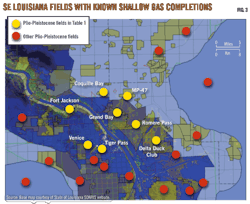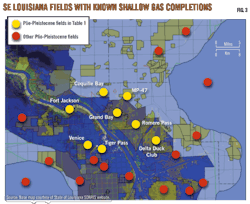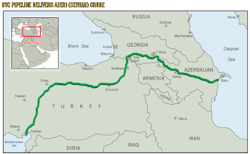Guntis Moritis
Production Editor
BP PLC has drawn up plans to redevelop Schiehallion and Loyal fields in UK Quadrants 204 and 205, about 130 km west of Shetland (Fig. 1).
The redevelopment plan includes additional subsea completed wells and flowlines tied in to a new floating, production, and offloading vessel that will replace the existing Schiehallion FPSO that started receiving oil in 1998.
A recent press release from Hyundai Heavy Industries said that BP had let a $1.2 billion contract, pending the sanctioning of the Quad204 project, to Hyundai for construction of 270-m long by 52-m wide FPSO able to process 130,000 b/d of oil, 220 MMscfd of gas, and 310,000 bw/d, as well as to store 1.06 million bbl of oil (Fig. 2). Hyundai plans to deliver the FPSO in early 2015.
BP expects to sanction the project this month and the information in this article on BP's redevelopment plan came from BP's November 2010 Quad204 project environmental statement.
Interest owners in Schiehallion are operator BP Exploration Operating Co. Ltd. 33.35%, Shell UK Ltd. 33.35%, Hess Ltd. 15.67%, Statoil (UK) Ltd. 5.88%, OMV (UK) Ltd. 5.88%, Murphy Petroleum Ltd. 5.88%
In the Loyal field, operator BP Exploration holds 50% with Shell UK holding the remaining interest.
Project background
Well 204/20-1 and sidetrack 204/20-1z discovered Shiehallion in 1993. Loyal was discovered in 1994 with Well 204/20-3. The fields were developed in several phases that added more producing and injection wells.
Currently, the fields produce from five drill centers with 54 wells. Schiehallion has 22 producers (two of which originate from a single multilateral well) and 23 injectors, while Loyal has 4 producers and 4 water injectors. The fields also have a gas disposal well that was used before completion of the gas sales line.
A pipeline transports produced gas to the Sullom Voe terminal and shuttle tankers carry oil also to Sullom Voe.
BP estimates that the fields have recovered about 350 million bbl of oil and 163 bcf of gas to yearend 2009.
The redevelopment option BP is pursuing will install a new internal turret-moored FPSO at the same location as the existing Schiehallion FPSO. It plans to continue transporting gas to Sullom Voe in the existing West of Shetland Pipeline System and to export oil to an onshore terminal or direct to market in Northern Europe.
BP also indicates that the area has several oil and gas discoveries that could tie in to the Quad204 infrastructure.
For the redevelopment, BP expects to install the subsea infrastructure in 2013, start drilling new wells in 2014, remove the existing FPSO in third-quarter 2014, install the new FPSO in first-quarter 2015, and obtain first oil in fourth-quarter 2015.
Redevelopment wells
Schiehallion and Loyal produce a medium crude that contains relatively low amounts of volatile components. Oil from Scheihallion has a 26° gravity, 3.27 cp viscosity, 9% wax content, and 0.3% asphaltene content. Initial GOR at Scheihallion was 380 scf/stb.
Loyal's oil has a 25° gravity, 1.86 cp viscosity, 5.2% wax content, and 3.6% asphaltene content. Initial GOR at Loyal was 512 scf/stb.
The redevelopment may require 49 additional subsea production and water injection wells drilled at the five existing drill centers in three phases.
Phase 1 includes infill drilling of 17 producers and 8 water injectors, sanctioned on a well-to-well basis, depending on economic conditions, with drilling occurring between 2014 and 2021. Scheihallion will have 20 of these wells while the rest will be drilled on Loyal.
Phases 2 and 3 are longer term and include potentially adding 24 infill wells, 23 on Scheihallion and 1 on Loyal. BP plans to sanction the wells on a well-by-well basis depending on the economics
To drill the new wells, BP expects to use conventionally moored fourth-generation or higher semisubmersible rigs.
The plan does not include any additional drill centers, but the company may add new centers for developing the Alligin field or other future tie-back fields to the Schiehallion and Loyal infrastructure (Fig. 3).
The redevelopment aims to produce additional reserves from the extensively faulted and compartmentalized Lower Paleocene stacked deepwater turbidite sandstones that are a combination of both channel and sheet-like complexes.
The wells will be directionally drilled and completed with the standard west of Shetland four casing strings. Planned hole diameters are 36-in. with 30-in. casing, 26-in. with 20-in. casing, 171⁄2-in. with 133⁄8-in. casing, 121⁄4-in. with 121⁄4-in. casing, and 81⁄2-in.
In the producing wells, the plan calls for drilling the surface, upper, middle holes with water-based mud, and using low toxicity mineral oil-based mud in the lower section and in the reservoir section, except in wells that may be gravel packed. These wells will use water-based mud in the 81⁄2-in. hole.
BP plans to dispose of the water-based mud cuttings from the top two hole sections on the seabed, while the water-based mud cuttings from the middle hole will be discharged to the seabed after cleaning and mud removal. Currently oil-based mud cuttings are shipped to shore for treatment and disposal, although the company is also considering offshore treatment of the cuttings.
For the 81⁄2-in., BP may use various types of completion equipment that may include stand-alone screens, expandable screens, or openhole gravel packs. BP expects sand fill as the main likely well problem in the field.
The plan notes that the water-injection wells will likely be drilled with water-based mud.
In its drilling schedule, BP has also incorporated a well workover every year with an average duration of 60 days.
Subsea infrastructure
The plan calls for the use of the existing infrastructure including all of the existing production and water injection wells.
New infrastructure additions include five production flowlines, one dynamic umbilical, two static umbilicals, five production risers, one gas riser, one production manifold, and one water injection manifold.
All wells will be drilled through horizontal trees with a flow base, as currently installed on the fields. The trees will have hydraulically operated valves with manual backup valves to provide pressure-integrity barriers from the reservoir for primary well control and a mechanism for well entry during well intervention.
The wells also will have a hydraulically operated downhole safety valve set for failsafe close.
The plan also includes installation of flowlines for providing gas lift via the tubing-production casing annulus to optimize well production.
BP will use water injection to provide reservoir pressure maintenance and also for sweeping oil towards to the producing wells.
Control of the production and water-injection trees will be remotely done from the FPSO through control umbilicals to several hydraulically activated valves and chokes. The valves will be controlled with a subsea control module that is mounted on the trees.
The flowline size in the field will be 8-in. or 10-in. production lines, 10-in. or 12-in. water injection lines, 6-in. or 8-in. gas lift lines, and 6-in. by 6-in. by 2-in. flexible jumper bundles.
Currently the field has 15 flexible risers installed and the plan calls for adding 5 production risers and 1 gas riser.
The new FPSO will require 20 new mooring lines and 20 new suction anchors. The installation work on the new FPSO will require reattachment of existing umbilicals, risers, and flowlines and hook-up of the planned additional infrastructure.
Another feature on the FPSO are three aft thrusters for close-approach work such as heading control during offloading operations and during difficult sea conditions.
Processing equipment
BP's plan for the processing of the produced fluid (Fig. 4) calls for the fluid first to enter a slug catcher where gas-liquid separation occurs. After preheating the stream, the liquids will enter a two-parallel, three-phase, first-stage separators. The separated oil will then be heated before further three-phase separation in a single two-stage separator. Final treated oil will be cooled before it enters the cargo tanks.
The process will also have a three-phase test separator.
To remove additional water from the crude, the plan calls for the crude oil run down line to the cargo tanks to have an inline compact electrostatic coalescer.
The processing includes a single low-pressure and two three-stage high-pressure compression systems for handling the gas for fuel, export, and gas lift.
For cleaning the water, the plan calls for deoiling hydrocyclones to treat the water removed from the separators and dissolved gas floatation to meet a target maximum oil in water specification of 15 mg/l.
In the process, desanding cyclones upstream of the deoiling hydrocyclones and injection pumps will remove sand and other solids.
The plan notes that produced water supplemented by deaerated seawater as needed will be injected for reservoir pressure maintenance.
For power generation, the FPSO will have four dual-fuel turbine generators with a total load requirement of 89 Mw.
More Oil & Gas Journal Current Issue Articles
More Oil & Gas Journal Archives Issue Articles
View Oil and Gas Articles on PennEnergy.com






